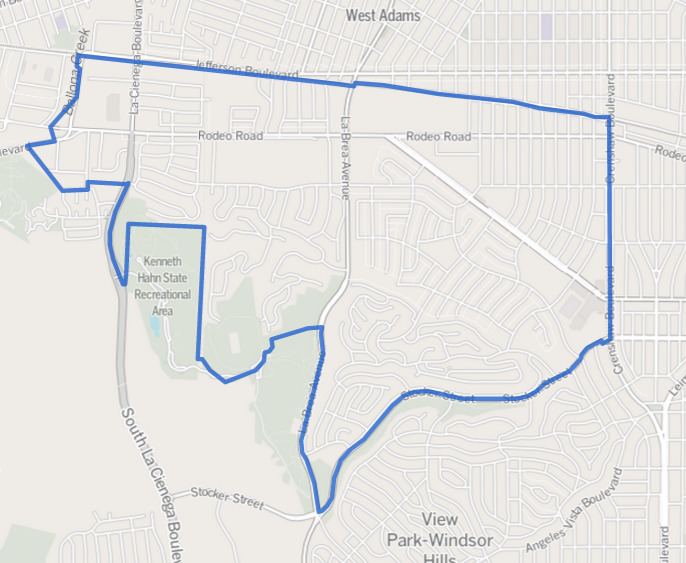 | ||
Crenshaw, informally as the Crenshaw District, is a neighborhood and district in the southwestern region of the city of Los Angeles, California. It derives from its namesake Crenshaw Boulevard, one of the city's major principal thoroughfares.
Contents
- Map of Crenshaw CA USA
- Geography
- Education
- Government
- Post office
- Neighborhood
- Transportation
- Notable places
- Special events
- Demographics
- Notable people
- References
Map of Crenshaw, CA, USA
The Crenshaw business commercial corridor along this street has had many different cultural backgrounds throughout the years but still has a positive African American commerce with many other ethnicity groups in recent years.
Geography
According to the Mapping L.A. project of the Los Angeles Times, Crenshaw is bordered by Chesterfield Square on the east, Hyde Park on the south, View Park-Windsor Hills on the west. It includes Leimert Park.
Street limits of the Crenshaw neighborhood are: Van Ness and Arlington Avenues; east, Exposition Boulevard on the north, La Brea Avenue near Baldwin Hills; west, and roughly Stocker Street & Slauson Avenue on the south. The Crenshaw Strip is the area directly stretched on Crenshaw between Exposition Boulevard on the north and Vernon Avenue on the south.
Education
Public schools are operated by the Los Angeles Unified School District (LAUSD).
The district's Charter schools in the area include the KIPP network. KIPP Academy of Opportunity middle school, Celerity Nascent Charter School the New Design Charter School (built in 2004), View Park Preparatory High School, and View Park Preparatory Middle School.
Government
As a neighborhood within Los Angeles city limits, Crenshaw does not have its own municipal government. It is appointed by the Crenshaw Chamber of Commerce.
Post office
The United States Postal Service operates the Crenshaw Post Office and the Julian Dixon Station.
Neighborhood
Crenshaw is a largely residential neighborhood of single-story houses, bungalows and low-rise condominiums and apartments. There are also commercial buildings with an industrial corridor along Jefferson Boulevard. There are also several other commercial districts throughout the neighborhood.
After courts ruled segregation covenants to be unconstitutional, the area opened up to other races. A large Japanese American settlement ensued, which can still be found along Coliseum Street, east and west of Crenshaw Boulevard. African Americans started migrating to the district in the mid 1960s, and by the early 1970s later were the majority.
In the 1970s, Crenshaw, Leimert Park and neighboring areas together had formed one of the largest African-American communities in the western United States. Crenshaw had suffered significant damage from both the 1992 Los Angeles riots and the 1994 Northridge earthquake but was able to rebound in the mid 2000s with the help of redevelopment. Crenshaw has significant affluent middle-class areas, and some areas with some poverty rates.
In 2006, the population of Crenshaw was around 27,600. Currently, there is a huge demographic shift increased in where many middle and lower-class blacks and Latinos are migrating to cities in the Inland Empire as well as cities in the Antelope Valley sections of Southern California as a form of gentrification. Despite the current major demographic shift, blacks had maintained their status as one of the neighborhood's largest ethnic group, with African-Americans forming 63.34% of the population, followed by Whites and Latinos (any race) at 30%, white (not Latino), 16.89%; Asian, 4.38%; American Indians, 0.43%; Native Hawaiian and other Pacific Islanders, 0.20%; other races, 9.20%; two or more races, 9.32%.
Transportation
The Metro Crenshaw LAX Line is a light rail line now under construction. It will run between the Expo/Crenshaw station and Aviation/96 Street station, transiting generally north-south along Crenshaw Boulevard and passing through Leimert Park and the city of Inglewood.
Notable places
.
Special events
Demographics
In the post-World War II era, a Japanese-American community was established in Crenshaw. There was an area Japanese school called Dai-Ichi Gakuen. Due to a shared sense of being discriminated against, many of the Japanese-Americans had close relationships with the African-American community.
At its peak, it was one of the largest Japanese-American settlements in California, with about 8,000 residents around 1970, and Dai-Ichi Gakuen had a peak of 700 students.
Beginning in the 1970s the Japanese American community began decreasing in size and Japanese-American businesses began leaving. Scott Shibya Brown stated that "some say" the effect was a "belated response" to the 1965 Watts riots and that "several residents say a wave of anti-Japanese-American sentiment began cropping up in the area, prompting further departures." Eighty-two-year-old Jimmy Jike was quoted in the Los Angeles Times in 1993, stating that it was mainly because the residents' children, after attending universities, moved away. By 1980, there were 4,000 Japanese ethnic residents, half of the previous size. By 1990 there were 2,500 Japanese-Americans, mostly older residents. By 1993, the community was diminishing in size, with older Japanese Americans staying but with younger ones moving away. That year, Dai-Ichi Gakuen had 15 students. Recently there has been a shift in a new generation of Japanese Americans moving back into the neighborhood.
